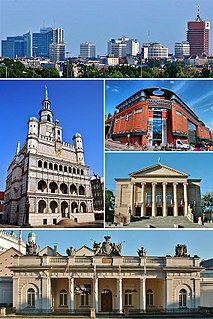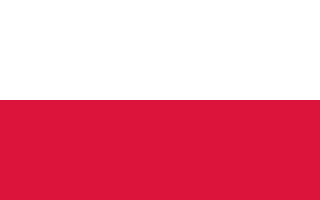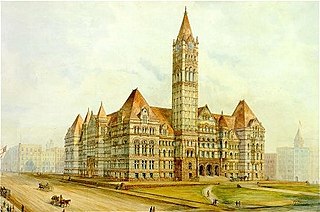


Strzeszyn [ˈstʂɛʂɨn] is a suburban neighbourhood of the city of Poznań in western Poland. It is located in the north-west of the city, to the west of Podolany, from which it is separated by the main railway line running northwards towards Piła. A railway station called Poznań Strzeszyn is situated on this line some distance north of the residential parts of Strzeszyn.

Poznań is a city on the Warta River in west-central Poland, in the Greater Poland region and is the fifth-largest city in Poland. It is best known for its renaissance Old Town and Ostrów Tumski Cathedral. Today, Poznań is an important cultural and business centre and one of Poland's most populous regions with many regional customs such as Saint John's Fair, traditional Saint Martin's croissants and a local dialect.

Poland, officially the Republic of Poland, is a country located in Central Europe. It is divided into 16 administrative subdivisions, covering an area of 312,696 square kilometres (120,733 sq mi), and has a largely temperate seasonal climate. With a population of approximately 38.5 million people, Poland is the sixth most populous member state of the European Union. Poland's capital and largest metropolis is Warsaw. Other major cities include Kraków, Łódź, Wrocław, Poznań, Gdańsk, and Szczecin.

Podolany is a suburban neighbourhood of the city of Poznań in western Poland, located in the north-west of the city. Podolany was incorporated into the city partly in 1933, and partly under German occupation in 1940–42. It is mainly a residential district, but its southern parts contain industrial sites.
Until 1990 Strzeszyn was part of the wider district (dzielnica) of Jeżyce, and remains so for certain administrative purposes. In 1996 an osiedle (urban neighbourhood with an elected council) of Strzeszyn was created. [1] This, with modified boundaries, is now one of the 42 osiedles into which the entire area of Poznań is divided (see Administrative division of Poznań). In 2010 the population of Strzeszyn osiedle was 6,703, and it covered an area of 12 square kilometres (4.6 sq mi).
In the Polish system of local administration, a dzielnica is an administrative subdivision or quarter of a city or town. A dzielnica may have its own elected council, and those of Warsaw each have their own mayor (burmistrz). Like the osiedle and sołectwo, a dzielnica is an auxiliary unit of a gmina. These units are created by decision of the gmina council, and do not have legal personality in their own right.

Jeżyce is a part of the city of Poznań in western Poland. It was one of the five governmental districts (dzielnicas) into which the city was divided prior to 1990, and which are retained for certain administrative purposes. For details, see Administrative division of Poznań.
Osiedle is a term used in Poland to denote a designated subdivision of a city or town, or of a dzielnica, with its own council and executive. Like the dzielnica and sołectwo, an osiedle is an auxiliary unit of a gmina. These units are created by decision of the gmina council, and do not have legal personality in their own right. In the case of an urban-rural gmina, it is also possible for a whole town to be designated an auxiliary unit.
Straeszyn is conventionally divided into several parts: Strzeszyn Stary (Old Strzeszyn) to the north, and the newer estates to the south: osiedle Literackie ("literary estate"; also known as osiedle Parkowe "park estate"), whose streets are named after writers; Strzeszyn Grecki ("Greek Strzeszyn"), whose streets are named after Ancient Greeks and Romans; and osiedle Wojskowe ("military estate"), built around 2010 chiefly for military personnel.
To the south is the artificial lake Rusałka, constructed during Nazi occupation on the Bogdanka stream. Further to the north, also on the Bogdanka, to the north-west of the residential parts of Strzeszyn, is the natural Jezioro Strzeszyńskie (Strzeszyn Lake), next to which is the recreational area of Strzeszynek (the name being a diminutive of "Strzeszyn").
The village of Strzeszyn was first recorded in 1388. A church stood there in the 15th and 16th centuries. The village became part of the city of Poznań in 1940, during the Nazi occupation.
A parish church, named for Padre Pio (kościół parafialny św. Ojca Pio) was completed in Strzeszyn Grecki in 2011. Old Strzeszyn is served by the parish church in Podolany to the east.

Padre Pio, also known as Saint Pio of Pietrelcina, O.F.M. Cap., was a friar, priest, stigmatist, and mystic, now venerated as a saint in the Roman Catholic Church. Born Francesco Forgione, he was given the name of Pius when he joined the Order of Friars Minor Capuchin.













